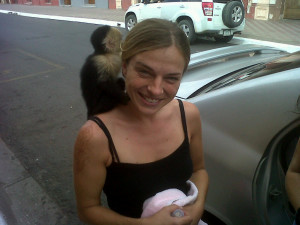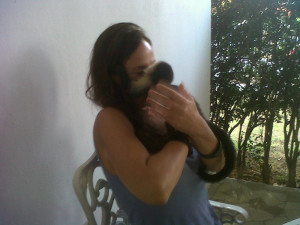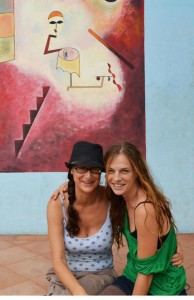Somehow the sight of a baby monkey on a leash and in a cage, did not exactly thrill us. The opposite. We felt an enormous amount of despair at how the monkey got to be in a cage in the first place and secondly, how the owner, who self admittedly knows very little about monkeys, could possibly accomodate a baby monkeys needs effectively. The monkey’s face expressed it all – extreme sadness. It clearly was experiencing the difficulties of life without his mommy and of life trapped in a cage.
Ben has always had an affinity for monkeys, especially capuchins. His father came home with two of them one day when he was a young boy growing up in Paris. Of course, at that time, there was much less awareness about having wild animals in captivity or as pets. The tales Ben has told me about that experience focus around how anti social and miserable monkeys in captivity and their owners become. However, one good result is that he (Ben) knows how to make monkey sounds and so the very sad monkey that was being shown off on the owners arm, snuggled into Ben’s chest and after a few mutual monkey call and response type conversations, shut it’s eyes and curled up to sleep, much to the surprise of the owner.
What followed for Ben and me were many discussion of what to do about the baby monkey. We did some research and were overwhelmed by the very sad reality of the exotic pet trade. (This typically involves shooting the mother animal in order to get the baby. No maternal adult monkey would give up their baby, much less not attend to it minute by minute.) Capuchins are exceptionally intelligent animals, as are all monkeys and never make good pets.
We emailed our research to the owner of the hotel… the reality of a monkey being a very social animal and needing to be with other monkeys, as well as having a variety of needs nutrition wise and the ability to “source” its’ own food..
No response.
Ben went to visit the baby monkey a few times, and I stayed away, not wanting to bear witness to this babys’ sadness. We began to manifest possible solutions. (We are big on manifesting, as you will know if you read our blog.) We dreamt of a monkey expert and Ben even suggested to the owner of the hotel that he hire a “monkey mama”… perhaps a zoological student who has studied animals and would be able to take the time with the monkey. Followed by eventual reimersion in the wild. It all felt as though our attempts and pleas were falling on deaf ears.( The only “plan” was to drop the monkey on the side of the road if it got to be too much trouble. In the meantime it was alive and being fed bananas. That was the extent of the care.)
And then….
one day.. at yoga.. we met Monica.
Monica was at the start of travelling through Central America and had just arrived in Nicaragua and had met the little capuchin monkey at the hotel and named him Lolo. She has experience working with primates in Cameroon Africa, where she worked and lived for a year at a rescue center, as well as at a center in Hawaii before that. Monica (monkey Monica as she became known), confirmed our fears on all counts.
The baby monkey, known as Lolo would need milk fed to him in a bottle, not just fruit, need a ton of climbing time and time to learn how to be a monkey, from other monkeys. While Monica researched the possible options for Lolo, she spent a week taking Lolo out of the cage and teaching him to look for bugs and insects and allowing him time to climb freely as monkeys like to do, in the trees of the hotel’s courtyard. She did this about six hours a day and by the time we met her, she had a plan of action.
Lolo would go to the Wildlife Animal rescue center in Managua. The only one of it’s kind in Nicaragua. Monica wondered if we had a car to take her and Lolo to the rescue center, the hour away. She had few resources and hardly any Spanish. The plan was for her to live there for a week or two while Lolo transitioned to her new life with other monkeys with the ultimate plan being for him to be released into the wild when ready.
We hired a taxi and Ben, myself, Monica and Lolo left the hotel in order to “save Lolo.” Seeing Lolo now, after having had time out of the cage and receiving the TLC he needed… Lolo was clearly a very different monkey! In the taxi Lolo mostly sat on top of Monica’s head, slept there and held on by holding on to her eyebrows and ears. Monica clearly was used to this….. Upon arrival at the center, it was established that no there was no place for Monica to live and that Lolo could be left there in a cage until the morning when he would be assessed for further placement and action.
Long story short, we found ourselves off to eat Korea food, with a monkey in tow and back to our house for the night with Monica and a capuchin monkey – they spent the night in the guest room. Next day Monica headed back to the center to leave Lolo there. Monica lived with us for almost two weeks and during the day took a bus to the center and back in order to volunteer time and to assist Lolo’s transition.
It became very clear very soon how understaffed and underfunded the center is. It is an extremely well intentioned place run by a wonderful woman, Marina, but it is overcrowded. No animal brought in is turned away. The heartbreaking situation of wild animals in tiny cages prompted Monica’s passion for animals to start a fundraiser and blog using the voice of Lolo. To read the story and details (all really well written and with good photographs) here it is:
http://whoislolo.wordpress.com/
 |
| Leaving Granada with Monica and Lolo, by taxi.. heading for the Wildlife Animal Rescue Center in Managua |
 |
| Orphaned babies need milk from bottles |
 |
| Monica and Lolo |
 |
| Lolo comes over to give me a snuggle and check out my face CLOSE up! |
 |
| Peta and Monica outside Casa Hubbert Peak |